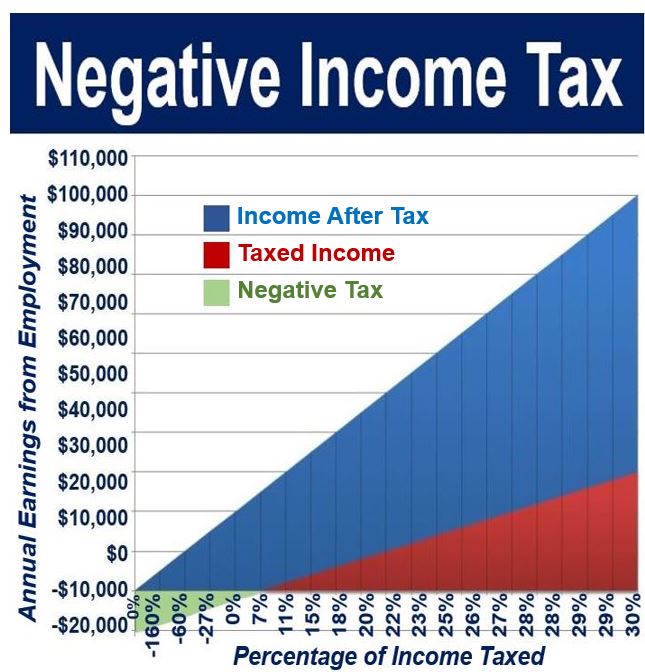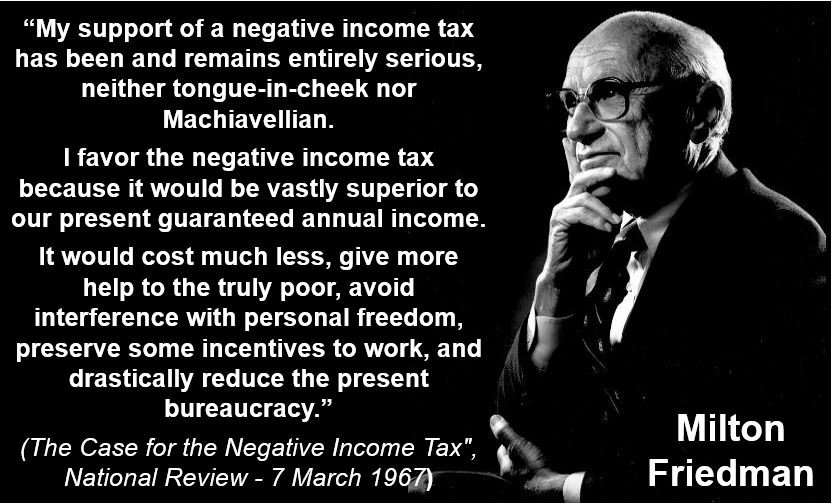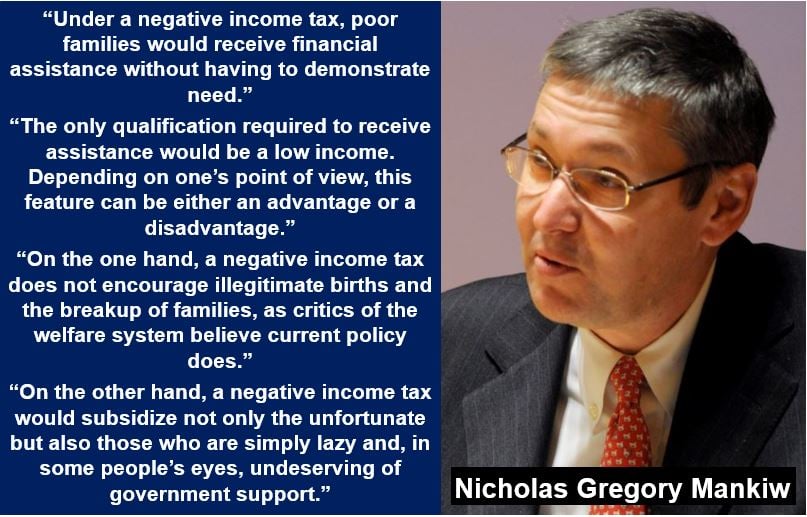Negative income tax, also known as earned income tax credit in the United States and Working Tax Credit in the United Kingdom, is a tax system in which low-income workers are eligible for supplemental pay from the government rather than paying taxes. It is a way of redistributing wealth through the taxation system by taking money from high-income individuals and paying it to those on low incomes.
Negative income tax, also known as NIT, has less stigma attached to it than other forms of welfare assistance.
 Example
Example
Imagine a man’s job pays $5,000 annually. He receives $10,000 annually from the government in working tax credit – $2,000 is taken from his working income; at the end of the year he has $13,000 net. Now, imagine a woman earns $10,000 from her job – she gets $10,000 from the government but pays $4,000 in tax; so at the end of the year her net income is $16,000.
Critics say that the system encourages low-income employees to stay stuck in the poverty trap, because it discourages them from working to raise their income.
Negative income tax – idea not new
For over seventy years, economists and lawmakers on both sides of the Atlantic have been talking about an earned income tax credit. British politician Juliet Rhys-Williams (1989-1964) put forward the idea in the 1940s, and in his 1962 book – Capitalism and Freedom – the notion was mentioned by monetarist economist Milton Friedman (1912-2006).
The system that Prof. Friedman proposed would be administered alongside the current income tax system.
According to Prof. Friedman, he recognized that his proposal carried inherent risks. He explained that, like any measure designed to alleviate poverty, it might diminish the incentives for self-reliance. However, unlike a system that merely supplements incomes up to a fixed minimum, his approach preserves some of that incentive; since every extra dollar earned still translates into additional spending power.
 The idea behind the system is for workers earning a certain income level to owe no taxes, while those earning more than that amount would pay a proportion of their income above that level in taxes. Those earning below the minimum level would be given a payment – enough to bring up their income to that minimum level.
The idea behind the system is for workers earning a certain income level to owe no taxes, while those earning more than that amount would pay a proportion of their income above that level in taxes. Those earning below the minimum level would be given a payment – enough to bring up their income to that minimum level.
Supporters say that an earned income tax credit – which in reality is euphemism for a tapered-off guaranteed income – would not discourage people from working or working harder than a straight guaranteed income would.
Negative income tax – criticism
Henry Stuart Hazlitt (1894-1993), an American journalist who wrote about business and economics for The Wall Street Journal, The Nation, The American Mercury, Newsweek, and The New York Times, explained in an article in the Mises Institute – Fallacies of the Negative Income Tax – that he abandoned the negative income tax proposal when he realized that it led straight into a dilemma:
“Which is precisely the dilemma of the working tax credit: either it is altogether inadequate at the lower end of the scale of self-earnings, or it is unjustifiably excessive at the higher end.”
“Either it must pay only half an adequate income (by its own definition of “adequate”) to a family that earns no income, or it must pay nearly twice an adequate income to a family that already earns an almost adequate income.”
The problem with earned income tax credit, Hazlitt added, is that it evades or glosses over the problem of families or individuals with no income at all – zero income.
If a zero income individual received $300 – the amount Prof. Friedman had originally proposed in 1962 – everybody would say that it was nowhere near enough to live on, particularly if, as Prof. Friedman also suggested, negative income tax became a complete substitute for all other types of welfare and relief.
 Milton Friedman (1912-2006) was an American economist who was awarded the 1976 Nobel Prize for Economics. He was a leading intellectual among the second generation of Chicago price theory. Friedman was economic adviser to US President Ronald Reagan and British Prime Minister Margaret Thatcher during the 1980s. (Image: Wikipedia)
Milton Friedman (1912-2006) was an American economist who was awarded the 1976 Nobel Prize for Economics. He was a leading intellectual among the second generation of Chicago price theory. Friedman was economic adviser to US President Ronald Reagan and British Prime Minister Margaret Thatcher during the 1980s. (Image: Wikipedia)
Hazlitt believed that if the negative income tax system were ever adopted, the political pressure to make it provide at least a poverty-line income of $3,400 to individuals with zero income would be irresistible. (These figures were quoted for individuals in 1962, and would involve considerably larger sums today).
Hazlitt argued that the basic subsidy under a Negative Income Tax (NIT) would be equivalent to that of a straightforward guaranteed income.
For example, if a family with no income were to receive a $3,400 subsidy, then under an NIT with a 50% incentive formula, the government support would continue until the family’s annual income reached $6,800. Given that this threshold surpasses the median family income of $6,637 in 1963, he concluded that such a policy would be fantastically expensive.
There would also be serious problems of equity. When a family receiving negative income tax was earning $6,798, it would still be receiving a $1 subsidy. When earnings increased to $6,802, the earner would be thrown off the “gravy train” completely, and would have to wait until his or her income fell below $3,400 before getting back onto it.
“And what about the family that had been earning $3,402 all along, and had never got on the gravy train?” Hazlitt wondered.
 Nicholas Gregory Mankiw is an American macroeconomist, best known in academia for his work on New Keynesian economics. He is the Robert M. Beren Professor of Economics at Harvard University. He was Chair of the Council of Economic Advisers to US President George W. Bush from 2003 to 2005. Out of almost 50,000 registered authors, he was ranked the 23rd most influential economist globally in April 2016 by RePEc. (Image: adapted from cdn.thedailybeast.com)
Nicholas Gregory Mankiw is an American macroeconomist, best known in academia for his work on New Keynesian economics. He is the Robert M. Beren Professor of Economics at Harvard University. He was Chair of the Council of Economic Advisers to US President George W. Bush from 2003 to 2005. Out of almost 50,000 registered authors, he was ranked the 23rd most influential economist globally in April 2016 by RePEc. (Image: adapted from cdn.thedailybeast.com)
Negative income tax – implementation
Even though the NIT notion has been around for several decades, its total implementation has never been feasible – mainly for political reasons.
Most countries’ tax laws are extremely complicated. In order to get a negative income system off the ground, entrenched tax laws would need to be re-written.
However, some nations have introduced refundable (or non-wastable) tax credits that can be paid even in cases when there is not any tax liability to be offset, such as the Working Tax Credit in the United Kingdom and the Earned Income Tax Credit in the United States.
– United States: the federal Earned Income Tax Credit or EITC is given to low- to moderate-income active individuals and couples – particularly those that have children. How much EITC people receive depends on their income and how many children they have.
People with children whose annual incomes are below $37,870 to $51,567 – depending on how many dependent children they have – may be eligible for EITC payments.
Individual workers and married couples with no children, whose incomes are below $14,340 and $19,680 respectively, may receive a very small EITC payment.
– United Kingdom: Working Tax Credit, also known as WTC, is a state benefit made to low income people in work. It is a means-tested benefit that was introduced in 2003. Despite its name, it has nothing to do with the tax credits related to a person’s tax bill – WTC payments are used to top up workers’ wages.
Unlike most other benefits, WTC is paid by HMRC (Her Majesty’s Revenue and Customs). Childless couples, working families with dependent children, and working individuals may be entitled to WTC.
Low income people with dependent children may also be entitled to CTC (Child Tax Credit). CTC and WTC are assessed jointly, and families may still be eligible for CTC even if there is no working adult or their income is too high to receive WTC.
WTC and CTC are paid out in different amounts and layers after a family has been means-tested, and may include: a £1,890 basic element payment that everyone gets; a lone parent and couple element of £1,860; a 30-hour working week element of £775; a payment of £2,530 for a disabled worker; and an additional £1,075 payment for a severely disabled worker.
Eligible workers will get either one of those payments, or a combination of two or more.
US President Richard Nixon’s NIT proposal nearly made it through Congress.
In Israel, a policy called Negative Income Tax has been implemented for certain low-income brackets. However, it deviates significantly from the more comprehensive model that most advocates favor.
Working Tax Credit – disincentive effects
Jodie T. Allen, who has been a senior editor at the Pew Research Center for twelve years, summarized a series of studies carried out on negative income tax in the United States. Allen wrote:
“The Stanford Research Institute (SRI), which analyzed the SIME/DIME findings, found stronger work disincentive effects, ranging from an average 9 percent work reduction for husbands to an average 18 percent reduction for wives. This was not as scary as some NIT opponents had predicted.”
“But it was large enough to suggest that as much as 50 to 60 percent of the transfers paid to two-parent families under a NIT might go to replace lost earnings. They also found an unexpected result: instead of promoting family stability (the presumed result of extending benefits to two-parent working families on an equal basis), the NITs seemed to increase family breakup.”
Video – Friedman’s Negative Income Tax
In this 1968 interview – Firing Line with William F. Buckley Jr – Prof. Friedman is asked whether his proposed negative income tax might actually create a larger class of indolent and unemployed people.
